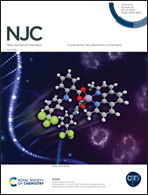A preliminary study of a 68Ga-labeled PET probe for HER2 imaging†
Abstract
Human epidermal growth factor receptor 2 (HER2) has emerged as an important molecular target for tumor diagnosis and therapy. The H6F peptide (YLFFVFER) selectively binds to the HER2 receptor. In this study, the H6F peptide was modified with glycine to improve water solubility and then linked to 1,4,7,10-tetraazacyclododecane-1,4,7,10-tetraacetic acid (DOTA) for gallium-68 (68Ga) labeling. The precursor was labelled with 68Ga to generate 68Ga-DOTA-GGG-H6F, and its stability and HER2 specificity were preliminarily assessed in vitro. Positron emission tomography (PET) imaging and biodistribution in human ovarian cancer SKOV-3 (HER2+) xenograft models revealed a high uptake of 68Ga-DOTA-GGG-H6F in SKOV-3 tumors. The uptake of 68Ga-DOTA-GGG-H6F in SKOV-3 tumors could be blocked by an excess of the H6F peptide. Furthermore, the uptake of 68Ga-DOTA-GGG-H6F in human breast cancer MDA-MB-231 (HER2−) tumors was low. HER2 expression was confirmed by immunohistochemistry and immunofluorescence staining. Autoradiography and pathological staining revealed a high correlation between radioactivity distribution and HER2 expression in tumors. These results confirmed the specificity of 68Ga-DOTA-GGG-H6F to HER2. In conclusion, we successfully developed a novel HER2-targeted PET imaging probe that exhibited significant potential for the detection of HER2 expression in tumors.



 Please wait while we load your content...
Please wait while we load your content...